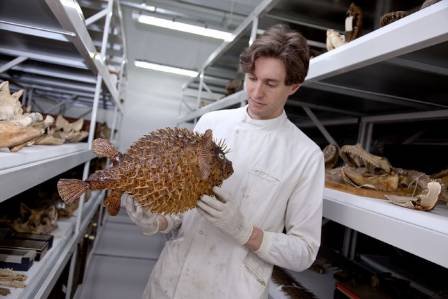And so dear reader, here it is, my first ever blog post. Until last week I thought there was more chance of me giving birth than ever blogging but when I was asked I thought well why not, it might be educational, for me and for you. As one of two fish curators here at the Museum it’s one of my jobs to enhance our already massive collection of fish specimens, and when the opportunity arose to do some collecting on the Isles of Scilly I leapt at the chance like a randy salmon. I hope, if you bear with me, I can give you an idea of what it's like to carry out field work for the Museum and also with any luck tell you a little bit about some of the fishes found on and around the islands.
 Me with one of the Museum's fish specimens in storage.
Me with one of the Museum's fish specimens in storage.
If (like me until recently) you are not familiar with the location of the Isles of Scilly, then I can now enlighten you. They are, I think, the most south-westerly part of the UK and lie about 30 miles to the west of Land's End, out in the Atlantic where relatively warm oceanic currents ensure that the climate is generally very mild compared to the rest of the country. This also means that they are potentially very interesting in terms of marine life. The last big collections of Scilly fishes that the Museum acquired were made in the 1970s and it's possible that things may have changed since then. The islands are likely to be one of the first ports of call for any species migrating north as oceanic temperatures rise.
I have compiled a list of all the fish species the Museum currently has from that locality (26 in total) and the aim of the trip will be to collect anything not already on that list, especially anything that has never been recorded before in any literature as being found on Scilly. However, it would still nice to get fresh specimens of those already listed as these can now be used for DNA analysis or for exchange with other museums. I particularly want to see clingfish, which are found, as the name suggests, clinging to boulders in rock-pools. What would be really exciting is to see a seahorse but as these are very special and protected I'm not permitted to interfere with them in any way so don't expect any pictures. We (me and my various assistants) are highly motivated and have small handnets, a 25m seine net and five fishing rods so nothing will escape us.
The main way of getting to the islands is on a boat called the Scillonian. I have to confess to being slightly nervous about this as I had a bad experience on a boat a few years ago from which I still bear the mental scars. On a really good day the trip takes about two and half hours and the passengers can expect to see whales, dolphins, ocean sunfish and basking sharks frolicking alongside the boat. On a bad day things aren't so jolly. I just Googled "scillonian vomit" and got 6,110 results, the first of which is titled "Scillonian Pukefest" and apparently the boat is also known as the "Vomit Rocket". Ah, how bad can it be? It'll be fine I'm sure when we sail on Tuesday.
Ok, that's it for now. Hopefully next time there will be some nice pictures of dolphins from the boat and fishes from the islands. Until the next time ...


